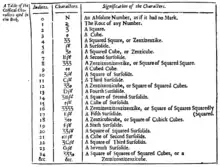Zenzizenzizenzic
Zenzizenzizenzic is an obsolete form of mathematical notation representing the eighth power of a number (that is, the zenzizenzizenzic of x is x8), dating from a time when powers were written out in words rather than as superscript numbers. This term was suggested by Robert Recorde, a 16th-century Welsh physician, mathematician and writer of popular mathematics textbooks, in his 1557 work The Whetstone of Witte (although his spelling was zenzizenzizenzike); he wrote that it "doeth represent the square of squares squaredly".
History

At the time Recorde proposed this notation, there was no easy way of denoting the powers of numbers other than squares and cubes. The root word for Recorde's notation is zenzic, which is a German spelling of the medieval Italian word censo, meaning 'squared'.[1] Since the square of a square of a number is its fourth power, Recorde used the word zenzizenzic (spelled by him as zenzizenzike) to express it. Some of the terms had prior use in Latin zenzicubicus, zensizensicus and zensizenzum.[2] Similarly, as the sixth power of a number is equal to the square of its cube, Recorde used the word zenzicubike to express it; a more modern spelling, zenzicube, is found in Samuel Jeake's Arithmetick Surveighed and Reviewed. Finally, the word zenzizenzizenzic denotes the square of the square of a number's square, which is its eighth power: in modern notation,
Samuel Jeake gives zenzizenzizenzizenzike (the square of the square of the square of the square, or 16th power) in a table in A Compleat Body of Arithmetick (1701):[3]
Indices Characters Signification of the characters 0 N An absolute number, as if it had no mark ... ... ... 16 ℨℨℨℨ A Zenzizenzizenzizenzike or square of squares squaredly squared ... ... ...
The word, as well as the system, is obsolete except as a curiosity; the Oxford English Dictionary (OED) has only one citation for it.[4][5] As well as being a mathematical oddity, it survives as a linguistic oddity: zenzizenzizenzic has more Zs than any other word in the OED.[6][7]
Notation for other powers
Recorde proposed three mathematical terms by which any power (that is, index or exponent) greater than 1 could be expressed: zenzic, i.e. squared; cubic; and sursolid, i.e. raised to a prime number greater than three, the smallest of which is five. Sursolids were as follows: 5 was the first; 7, the second; 11, the third; 13, the fourth; etc.

Therefore, a number raised to the power of six would be zenzicubic, a number raised to the power of seven would be the second sursolid, hence bissursolid (not a multiple of two and three), a number raised to the twelfth power would be the "zenzizenzicubic" and a number raised to the power of ten would be the square of the (first) sursolid. The fourteenth power was the square of the second sursolid, and the twenty-second was the square of the third sursolid.
Jeake's text appears to designate a written exponent of 0 as being equal to an "absolute number, as if it had no Mark", thus using the notation x0 to refer to an independent term of a polynomial, while a written exponent of 1, in his text, denotes "the Root of any number" (using root with the meaning of the base number, i.e. its first power x1, as demonstrated in the examples provided in the book).
Citations
- Quinion, Michael, "Zenzizenzizenzic - the eighth power of a number", World Wide Words, retrieved 19 March 2010.
- Michael Stifel. Arithmetica Integra (in Latin). Nuremberg. p. 61.
- Samuel Jeake (1701). Samuel Jeake the Younger (ed.). A Compleat Body of Arithmetick. London: T. Newborough. p. 272.
- Knight (1868).
- Reilly (2003).
- "Recorde also coined zenzizenzizenzic, OED with more Zs than any other" (Reilly 2003).
- Uniquely contains six Zs. Thus, it's the only hexazetic word in the English language."Numerical Adjectives, Greek and Latin Number Prefixes". phrontistery.info. Retrieved 19 March 2010.
References
- Hebra, Alexius J. (2003), Measure for Measure: The Story of Imperial, Metric, and Other Units, The Johns Hopkins University Press, ISBN 978-0-8018-7072-9.
- Knight, Charles (1868), The English Cyclopaedia, Bradbury, Evans, p. 1045.
- Reilly, Edwin D. (2003), Milestones in Computer Science and Information Technology, Greenwood Publishing Group, p. 3, ISBN 978-1-57356-521-9.
- Todd, Richard Watson (2006), Much Ado About English, Nicholas Brealey Publishing, ISBN 978-1-85788-372-5.
- Uldrich, Jack (2008), "Chapter 2. The Power of Zenzizenzizenzic", Jump the Curve: 50 Essential Strategies to Help Your Company Stay Ahead of Emerging Technologies, Adams Media, ISBN 978-1-59869-420-8.